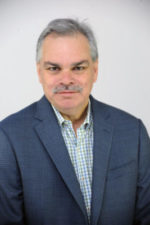
William Trollinger is professor of history in the History and Religious Studies Departments at the University of Dayton. He is also director of UD’s Core Integrated Studies Program, which features an innovative, five-semester interdisciplinary curriculum. He earned his B.A. in English and History from Bethel College (MN) and his M.A. and Ph.D. in History from the University of Wisconsin-Madison. His research has focused on 20th/21st-century American Protestantism, particularly fundamentalism, creationism, and Protestant print culture. His publications include God’s Empire: William Bell Riley and Midwestern Fundamentalism (University of Wisconsin Press, 1990) and Righting America at the Creation Museum (Johns Hopkins University Press, 2016), the latter which he co-authored with his wife, Susan Trollinger. He has also done a good deal of research on the Ku Klux Klan in Ohio in the 1920s; one result of this work is “Hearing the Silence: The University of Dayton, the Ku Klux Klan, and Catholic Universities and Colleges” (American Catholic Studies, Spring 2013), for which he won the 2014 Catholic Press Award for Best Essay in a Scholarly Magazine. He enjoys speaking on the 1920s Ohio Ku Klux Klan.
Statues, Flags, and the Ongoing Battle over the Meaning of the Civil War
The 2015 mass shooting in Charleston and now the recent events in Charlottesville have added fuel to the intense and sometimes heated debate in contemporary America about Confederate monuments and flags. What sometimes gets lost in this debate is that monuments and flags are not history themselves, but are commemorations of a particular interpretation of history. This is particularly true in this case. Most Confederate monuments were not constructed in the immediate aftermath of the Civil War, but, instead, were put up as part of the effort to create a “Jim Crow” South that rendered African Americans politically invisible and powerless. And the revival of Confederate flags was part and parcel of the mid-twentieth-century white resistance to the Civil Rights movement. In effect, the Confederate monuments and flags – and the fierce defense of both – are manifestations of the fact that the South lost the Civil War but won the writing of history. And the current opposition to Confederate monuments and flags grows out of a very deep desire to tell a new and more accurate story about our past.
Terrorizing Immigrants and Catholics: The Ohio Ku Klux Klan in the 1920s
Having virtually disappeared in the late nineteenth century, the Ku Klux Klan exploded onto the national in the early 1920s, with perhaps five million members at its peak. While the original Klan concentrated its animus against the newly freed slaves, this “second” KKK had an expanded list of social scapegoats that included immigrants, Jews, and Catholics. While the original Klan was based primarily in the South, the second Klan had its greatest numerical strength in the West and Midwest. In fact, Ohio may have had more KKK members than any other state in the Union, with an estimated 400,000 Klansmen and Klanswomen. In this presentation we will explore why the Klan was so strong in Ohio, what activities the Ohio Klan engaged in, and in what ways the folks targeted by the Klan fought back.
TO SCHEDULE A PRESENTATION , PLEASE CONTACT:
William Trollinger
wtrollinger1@udayton.edu
937-229-2827
Speaker Applications
If your organization would like to book a speaker, first contact the speaker to confirm program dates, times, and whether or not the program will be offered virtually.
After you have confirmed scheduling details, submit a speaker request form to Ohio Humanities at least six weeks before the presentation takes place. Upon approval, we’ll send you a program agreement packet and ask you to pay the appropriate application fee to Ohio Humanities. Groups are limited to three Speakers Bureau programs per year.
Speaker Fee Structure
Non-profit organizations with an annual budget under $150,000 pay a fee of $50.00.
Non-profit organizations with an annual budget over $150,000 pay a fee of $250.00.
Schools (including colleges or universities) and corporate or private entities pay a fee of $400.00.
For any questions, please contact Program Officer Melvin Barnes at mbarnes@ohiohumanities.org.
